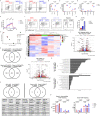This is a preprint.
Deficiency of metabolic regulator PKM2 activates the pentose phosphate pathway and generates TCF1+ progenitor CD8+ T cells to improve checkpoint blockade
- PMID: 37790365
- PMCID: PMC10543315
- DOI: 10.21203/rs.3.rs-3356477/v1
Deficiency of metabolic regulator PKM2 activates the pentose phosphate pathway and generates TCF1+ progenitor CD8+ T cells to improve checkpoint blockade
Update in
-
Deficiency of metabolic regulator PKM2 activates the pentose phosphate pathway and generates TCF1+ progenitor CD8+ T cells to improve immunotherapy.Nat Immunol. 2024 Oct;25(10):1884-1899. doi: 10.1038/s41590-024-01963-1. Epub 2024 Sep 26. Nat Immunol. 2024. PMID: 39327500
Abstract
TCF1high progenitor CD8+ T cells mediate the efficacy of PD-1 blockade, however the mechanisms that govern their generation and maintenance are poorly understood. Here, we show that targeting glycolysis through deletion of pyruvate kinase muscle 2 (PKM2) results in elevated pentose phosphate pathway (PPP) activity, leading to enrichment of a TCF1high central memory-like phenotype and increased responsiveness to PD-1 blockade in vivo. PKM2KO CD8+ T cells showed reduced glycolytic flux, accumulation of glycolytic intermediates and PPP metabolites, and increased PPP cycling as determined by 1,2 13C glucose carbon tracing. Small molecule agonism of the PPP without acute glycolytic impairment skewed CD8+ T cells towards a TCF1high population, generated a unique transcriptional landscape, enhanced tumor control in mice in combination with PD-1 blockade, and promoted tumor killing in patient-derived tumor organoids. Our study demonstrates a new metabolic reprogramming that contributes to a progenitor-like T cell state amenable to checkpoint blockade.
Keywords: CD8+ T cell; Immunotherapy; Non-small cell lung cancer; PKM2; TCF1; metabolic reprograming; pentose phosphate pathway.
Figures







References
Publication types
Grants and funding
LinkOut - more resources
Full Text Sources
Molecular Biology Databases
Research Materials
Miscellaneous

